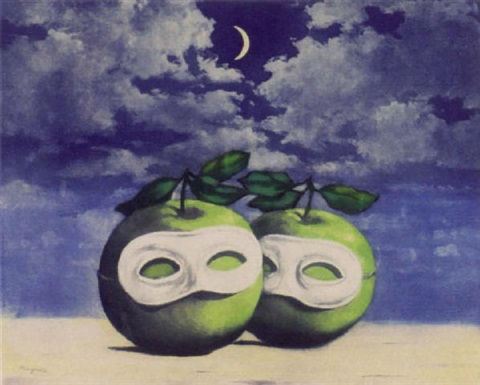La valse hesitation: Part II
- Amy Baker

- Feb 25, 2018
- 2 min read
Updated: Apr 26, 2018
Rene Magritte was one of the most accessible and famous surrealist painters of the 20th century. He maintained several tropes throughout his canvases. The man in the bowler hat is one of the most famous, and used to a great amount of fun to the backdrop of Nina Simone's "Sinner Man" in the Pierce Brosnan remake of "The Thomas Crown Affair."
But what is of particular note, to me, about Magritte is his stunning depth of awareness of the human condition and how it plays out in intimate relationships.

Here we have several tropes, as before in his earlier version of La valse hesitation. There is the fruit, ripe with metaphoric meaning in sexual relationship and sexual union, yet the seemingly healthy and sexually mature fruit sits side-by-side, a day at the beach, looking good, but not really seeing one another. Rather, they are each allowing themselves to be seen in the hidden way that they are allowing themselves to be seen. They have shown most of their best, and yet they hide.
How many of us has been in a relationship where we care about our outer selves and keep our eyes veiled, hidden. We look good, we are enticing to our partner, we are enviable to others, yet we stay just out of reach?
Coming from an Attachment Theory perspective, I would deconstruct this in the following ways:
Anxious Attachment Style
I am not good enough how I really am.
I am not worthy as myself.
I cannot trust being vulnerable and exposing myself.
I will keep this mask on so s/he won't see what I lack.
Avoidant Attachment Style
I am fine by myself.
I will not let her/him in.
I am independent.
S/he can tag along with me (to the beach), but I will not expose myself beyond what I want her/him to see.
If I trust her/him with being fully vulnerable and exposed, I might come to depend on her/him, and I CAN'T TRUST her/him with that!
What is tragic about this hiding is that these are merely learned coping strategies that protect the emotional interior state of the person with an insecure attachment style. These can be unlearned. My research as a social scientist has been precisely about to developing a healthier sense of self-worth and learning new skills within intimate partnerships to have BOTH higher relational satisfaction and higher sexual satisfaction--they go hand in hand.
Once individuals within the couples framework begin to see that some of their skills are working for them within their primary relationship, they often report positive shifts in other areas of their lives--more profound conversations, deeper intimacy within friendships, culling their social circle to limit time with more pessimistic people, and becoming the change they wish to see.




Comments